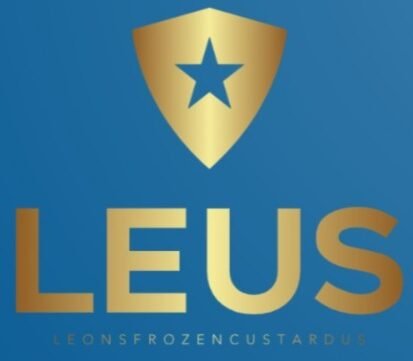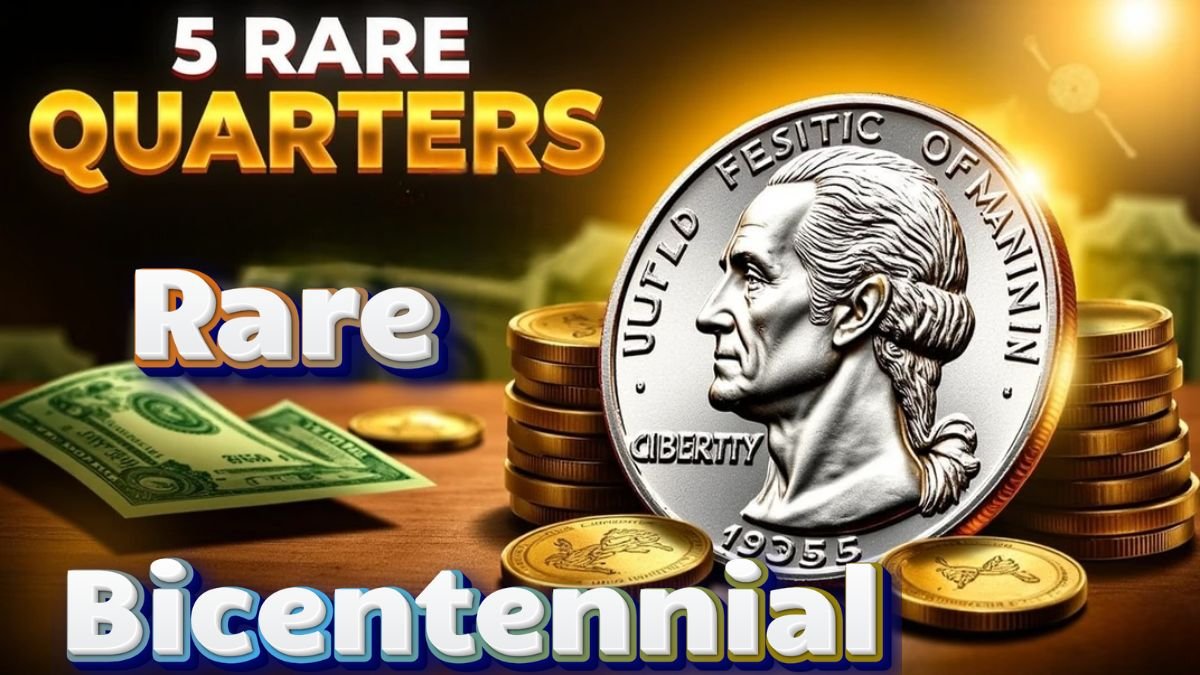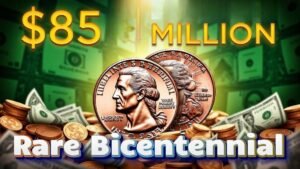Introduction
Then your pocket change would be a hidden treasure. Minted in 1975-1976, the Bicentennial is a landmark in American monetary history. Designed to celebrate the 200th anniversary of American Independence, these special rooms feature a distinctive drummer-boy style that sets them apart from regular spaces.
Millions of these have been made, but some rare species have attracted the attention of serious collectors. An extraordinary amount has been sold – up to $19,200 at auction. These valuable varieties include silver proofs, two die-defects and Jewelery cameo specimens that display exceptional artistry and historical significance.
Ready to find out if you have some valuable American history? Let’s explore a rare five-year bicentennial that could be worth a modest fortune.
The Historical Context of Bicentennial Quarters

In 1975, the United States Bank launched its Tricentennial Program in honor of America’s 200th birthday. This memorial service was a special moment in the US. history of the NACC, and celebrated two centuries since the signing of the Declaration of Independence
These four areas represented the first major shift in design in the US. subdivision of housing since 1932. When the US. Departing from the traditional Washington Quarterly reverse design, the bank held a national design contest, drawing entries from artists across the country. Jack L. .
This coin is especially important in American occult circles for several reasons.
- That’s the U.S. first double-dated coin (1776-1976).
- The program introduced 40% silver versions for collectors
- These four areas gave Americans a new passion for collecting
- The design change represented a rare departure from the U.S. of the traditional currencies
The massive production of 1.7 billion copies of the quarter ensured that these books would become a permanent monument to America’s bicentennial celebrations, making them historically significant and them collectors at all levels can access it.
Overview of Different Types of 1976 Bicentennial Quarters

U.S. The Bank held the Bicentennial in three separate locations, each offering a unique quality to this commemorative coin:
1. Philadelphia Mint (No Mint Mark)
- standard copper-nickel alloy
- maximum production quantity
- Regular strikes for distribution
2. Denver Mint (D Mint Mark)
- Copper-nickel plated surfaces
- Second highest number of mints
- It is known as multi-criteria error methods
3. San Francisco Mint (S Mint Mark)
- produced a special testimonial
- Mint 40% silver composition four pieces
- evidence and produced an unflattering pattern
The concept behind it is a revelation of a violin boy who created colonialism, inspired by a national design competition held by Jack El Ahr. This iconic image replaced the traditional eagle design with “1776-1976” and displayed the inscription “UNITED STATES OF AMERICA.” The drummer boy symbolizes the spirit of the American Revolution, wearing a triple hat and holding a torch of victory.
1976-S Silver Proof Quarter: The Crown Jewel

The 1976-S Silver Proof Quarter is the most impressive of the Bicentennial Quarter series. This unique coin has an impressive 40% silver content, setting it apart from normal wear.
Key Specifications:
- It weighs 5.75 grams
- Silver content: 40%
- Mint Mark: S. (San Francisco) .
- Surface – Proof finish with glassy surfaces
These masterpieces were produced by the San Francisco Mint with meticulous attention to detail. Each coin is heavily struck with particularly polished dies, which created sharp and well-defined effects as well as pristine details.
Market Performance:
- Recent sales record: $19,200
- Average MS-70 grade price: $2,000-$3,000
- MS-69 Grade Price: $800-$1,200
The exceptional value of the 1976-S Silver Proof Quarter comes from its perfect preservation and impeccable sophistication. Collectors display trophy examples:
- Deep objects such as crystals
- Details of a sharp blow to the drummer boy
- Signs of complete contact
- Perfect original mint shine
The top-graded examples show striking contrasts between frozen design elements and portrait locations. These antiques attract collectors and serious investors, providing competitive bidding at auctions.
1976-D Doubled-Die Obverse Quarter: A Mint Error Marvel

The 1976-D Doubled-Die Obverse Quarter is an interesting example of a mint error. This rare coin has the distinctive effect of doubling on the obverse side, especially in the words “LIBERTY” and the date “1776-1976”.
Doubling occurred during the Denver Mint die hubbing process when the dies had multiple sheens slightly offset from each other This discrepancy created a visible shadow effect on specific design features, making each coin unique and the gatherers sought him out earnestly.
- Two descriptions found in “LIBERTY.”
- A specific range of date numbers
- Double-click coverage of Washington
- Apparently doubly so in “THE ENCOURAGEMENT IN GOD.”
The current market price of $8,400 reflects exceptional rarity – experts estimate there are fewer than 100 certified examples. Professional awards have certified very few in mint man conditions, creating stiff competition among serious collectors.
Gold enthusiasts award these four sites prizes for the historical significance and unique story behind their creation. The death double flaw represents a perfect storm of circumstances: a special kind of commemorative architecture coupled with an important mint flaw during the American bicentennial celebrations.
1976-S Deep Cameo Proof Quarter: A Glimpse into Perfection

The 1976-S Deep Cameo Proof Quarter is a shining example of exceptional mintcraft, valued at an impressive $2,760 in pristine condition This stunning look stands out in the coin world for its stunning contrast material because of the designed and external interface.
Key Visual Features:
- Unusually prominent crystalline areas
- Deep frosted designs
- There are sharp, smooth words behind the drummer’s boy
- Pristine surface quality with no imperfections
The term Deep Cameo refers to the highest contrast that can be achieved in a proof setting. The large gap between the frozen machinery and the mirror-like spaces creates an almost three-dimensional appearance – a particularly striking feature of the Quartet’s reverse drummer boy design
Standard size quadrants typically exhibit low contrast between their design elements and locations. The 1976-S Deep Cameo variant achieves this superior finish through special minting techniques:
- Multiple strokes and polished dies
- Precise control of pressure during firing
- Planchet decoration went up
- Careful handling to preserve the wall properly
These four areas received special treatment from the San Francisco Mint, where master craftsmen used new dies, carefully selected planchets to create these masterpieces and intense visual techniques according to the coins to ensure that each coin meets the highest standards of certification coins for a profound cameo effect.
Other Notable Variants Worth Mentioning

In addition to the highly sought after, several other bicentennial quarters deserve recognition for their outstanding quality and value:
- 1976 No Mint Mark Quarter: These rare examples lack the required mint mark, creating an interesting anomaly for collectors. You can find this mandatory price between $100-$500 depending on condition.
- 1976 Struck-Through Error: These four pieces exhibit distinct scratches from foreign matter caught between die and planchet during striking and the resulting change in texture allows each piece to be assembled separately.
- 1976-D proof-like quarter: Although not officially proven, these parts exhibit an unusual surface quality that reflects off the highly polished dies that strike and are set apart by their glass finish for standard circulation strokes.
- 1976 Silver plated: A special type of silver that differs in some aspects from the usual copper-nickel alloy. These pieces contain 40% silver and carry a unique luster that is appealing to precious metal enthusiasts.
Each variation tells its own story through subtle differences in beat, composition, or mint characteristics. The search for this special edition heightens the interest in two-quarter centuries of collecting.
Conclusion
The rare bicentennial quarter isn’t just gold; They are important pieces of American history, each with its own story about our nation’s 200th birthday. These funds offer two benefits: excellent investment opportunities and a chance to explore the exciting world of fundraising.
Finding a variety of valuable pieces like a 1976-S Silver Proof or an interesting double-painted front end makes this trip even more enjoyable. Whether you’re interested in their historical significance or potential value, collecting these four unique sites brings you closer to a pivotal moment in American history
Wait no longer – order your collection now. You might stumble across a rare gem tucked away in your pocket change or waiting to be discovered at your local coin shop.
FAQ’s
What is a bicentennial quarter and why is it important?
They were issued during the Bicentennial of 1976 to commemorate the 200th anniversary of the Declaration of Independence. As representatives of America’s rich banking heritage, they hold historical significance and are valued by collectors.
What are the types of the third bicentennial of 1976?
There are several types of bicentennial quads, including ones in Philadelphia, Denver, and San Francisco. Each features a unique contrasting design depicting a boy playing a violin, setting it apart from the other pieces.
What makes the 1976-S Silver Proof quarters especially valuable?
The 1976-S Silver Proof Quarter is highly sought after for its unique and rare quality. Known for its incredible auction prices, one notable sale reached $19,200, making it a crown jewel for collectors.
1976-D What is the significance of the Doubled-Die Obverse Quarter?
The 1976-D Doubled-Die Obverse Quarter has an interesting mint flaw that makes it rare and desirable among collectors. This card is valued at approximately $8,400 due to its unique quality and collector interest.


